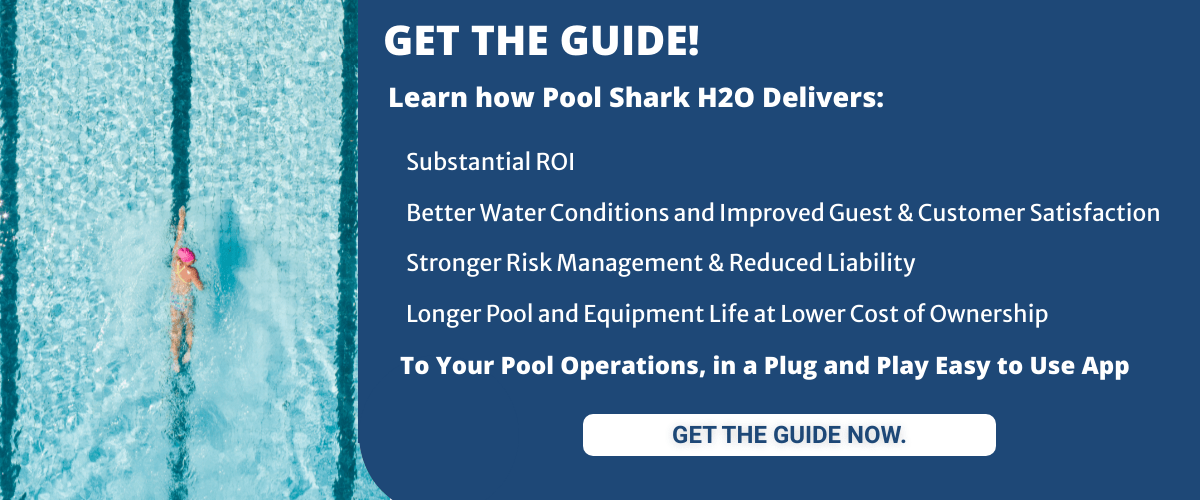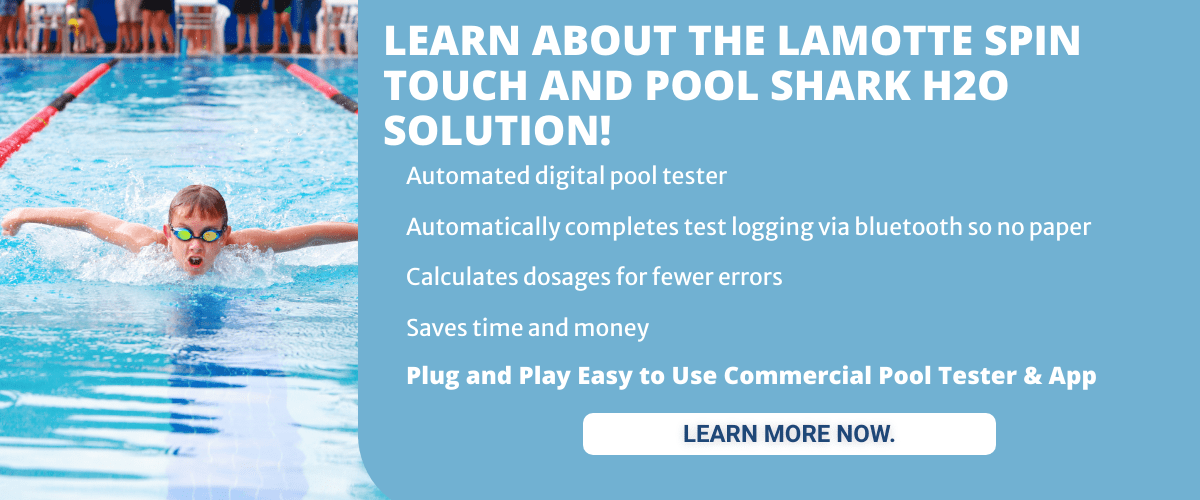Commercial pool chlorine management can be tricky in any case, and when the pool is indoors, getting it right is even more important.
That's because the pool affects the air quality at indoor pool facilities.
For many, when the seasons' change or the weather is unfavorable, swimming isn’t considered an ideal activity for exercise or recreation.
Meanwhile, the most avid swimmers among us simply switch to swimming at indoor pool facilities when outdoor pools aren’t an option. Families staying at hotels are often attracted to hotels with indoor pools also.
One issue that swimmers using indoor pools can run into is an intense chemical odor in and around indoor facilities. This odor is frequently misattributed to too much chlorine in the pool water, but it is really the indicator of a much more complicated issue. These odors can lead to serious health issues, particularly for people who frequently use indoor pools.
Causes of Indoor Commercial Pool Chemical Odor
The true cause of this odor is a reaction between the chlorine and contaminants in the pool. Chlorine is added to the pool to keep it clean, preventing algae growth and controlling microbes that can make swimmers sick. Urine, traces of feces, sweat, natural skin moisturizers and personal care products are all nitrogen containing contaminants that are added by swimmers entering the pool..
The more swimmers that are in the water and the “dirtier” they are, the greater the contaminant input, and therefore the more the reaction will occur. When chlorine reacts with the contaminants, it becomes trichloramine (TCA), also called chloramine or combined chlorine, which is chlorine that is now bound to a contaminant.
This type of chlorine can no longer react with contaminants, and can therefore no longer keep the pool clean. TCA is the cause of the strong chemical odor around indoor pools and can lead to respiratory health issues.
Contributing Factors to TCA in the Air in Indoor Commercial Pools, and Why Commercial Pool Chlorine Management is so Vital
Contaminants Entering the Water
As mentioned before, contaminants entering the water via the bodies of swimmers cause the reaction with chlorine that creates TCA. There are several practices that can minimize the contaminants entering the water by ensuring swimmers and staff are as clean as possible when they enter the pool and while they’re in the pool. Tips to reduce contaminants include, but aren’t limited to:
- DO NOT enter the water if you have diarrhea
- Use the toilet before entering the water
- Shower, even a brief rinse before entering the water (this washes off some contaminants like sweat)
- Wear a bathing cap when possible
- DO NOT pee or poop in the water
Using any of these precautions can prevent some contaminants from entering the pool, meaning less TCA will be formed and less TCA will be off-gassed into the air.
Water Mixing
Whenever the water in the pool is mixed or disturbed, the chloramines in the water have a greater opportunity to off-gas into the air. The number of bathers in the water contributes to the amount of water mixing, as the greater the amount of swimmers in the water, the more water is being disturbed. The activity level of the bathers is another contributing factor to the amount of water mixing. For example, a competitive swim meet that involves sets of swimmers quickly moving through the water over and over will disturb the water far more and therefore release more chloramines than a fitness class with stationary water activities. Unfortunately, there is no easy way to reduce the amount of mixing and the disturbance of the water without imposing unreasonable restrictions on the swimmers.
Airflow in Indoor Pool Facilities
Airflow throughout a facility, or lack thereof, can contribute to TCA buildup. The airflow in indoor facilities is handled by the heating, ventilation, and air conditioning (HVAC) system, which is responsible for continuously circulating fresh air into the facility. If the air isn’t recirculated properly, TCA will linger in the swimming area. Since TCA is heavier than air, this also means that it will settle at the lowest point in the facility, right above the water’s surface, where swimmers will inhale it frequently.
Indoor pool facility owners and operators must ensure that HVAC systems are optimized to recirculate fresh air across the surface of the pool to prevent TCA buildup. Particularly during the colder months, bringing fresh air into the facility may increase heating costs due to the exhausting of warm, TCA-filled air out of the facility, and its replacement with colder air. While this is an inconvenience and a greater potential expense, the costs of swimmer discomfort and illness linked to chloramines is often higher than the additional heating costs required during the colder months.
Health Effects of Poor Commercial Pool Chlorine Management
If nothing is done to control the amount of TCA in the air, what sorts of health effects can swimmers and pool staff expect? For one, chloramines like TCA can irritate the skin, eyes, and respiratory tract. Airway hyperresponsiveness, which is sometimes seen in asthma patients, can also occur when exposed to too many chloramines. Airway hyperresponsiveness occurs when the bronchial tubes in the lungs spasm abnormally and can lead to coughing and tightness in the chest. Competitive swimmers sometimes confuse these symptoms with the effects of strenuous training, and swimmers with asthma can experience asthma attacks due to TCA.
Chloramines can also contribute to changes in the airway mucosa. Some studies even suggest that taking infants and toddlers without mature lungs to indoor pools can potentially lead to a higher incidence of allergies and/or asthma. Pulmonologist Rachel Taliercio, DO, still says she wouldn’t advise parents to stop putting their kids in recreational swimming programs, as she says “There are too many overall health benefits kids get from swimming.” Despite this reassurance, minimizing the risk of a child getting asthma while swimming should be a top priority.
Using Technology to Mitigate the Risk of Poor Commercial Pool Chlorine Management
When dealing with minimizing the risk of swimmers suffering due to chloramines in the air, why not go to the source, to prevent chloramines from forming in the water in the first place? Monitoring the combined chlorine levels in pool water and dealing with them when they get too high can prevent chloramines from entering the air at all. Using modern testing and data recording methods can help with monitoring combined chlorine levels.
The LaMotte Spin Touch is a digital tester that can measure total, free, and combined chlorine levels in the water. In the past, pool staff needed to use separate non-digital testing methods to measure the total and free chlorine levels, then subtract free chlorine from the total to get the combined chlorine value. Now, the LaMotte Spin Touch can measure the levels of all chlorine types and can run seven other water tests simultaneously in under a minute. Spin Touch is not only more accurate and easier to use than non-digital testing kits, but it is far faster, saving time that could be productively spent elsewhere. Once the Lamotte Spin Touch has taken the water tests, iit can send its data via Bluetooth to a digital pool log like Pool Shark H2O.
Pool Shark H2O is a digital data storage platform for pool water testing data. It records water testing data like any physical pool log would, but stores the data in a secure cloud database, keeping data safe from being destroyed, lost or tampered with. This also allows managers to view the most recent testing data on their smartphones from anywhere with an internet connection.
Better still, Pool Shark H2O can use the data entered to calculate any necessary chemical additions to make corrections to the chemical levels, including indicating how and when to shock pools to get rid of combined chlorine/chloramines in the water. Shocking pools will prevent chloramines like TCA from lingering in the pool water. Allowing Pool Shark H2O to handle the calculations for chemical additions takes this complicated task out of the hands of pool supervisors, eliminating the opportunity for human error in the calculation to throw off chemical corrections.
Performing the necessary corrections by shocking the pool can save swimmers from asthma attacks and other negative effects to their respiratory systems. Staff must still be aware when they make corrections, as shocking the pool causes many chloramines to off-gas in the process. If this were to happen shortly before or during a swim meet, this would be bound to cause problems for swimmers, and should therefore be avoided. Make major corrections given by Pool Shark H2O and shock the pool on days when the pool is closed to avoid causing discomfort for swimmers.
Using Pool Shark H2O will not only keep pool operators and staff organized but can help them keep an eye on combined chlorine levels, which indicate the amount of TCA that can possibly enter the air. If combined chlorine levels are kept under control, pool operators won’t need to worry as much about other practices to keep TCA out of the air, and can make TCA far easier to control when it must be handled.
More Commercial Pool Chemistry Resources
Free, vs Combined vs Total Chlorine - A Guide for Commercial or Public Pool Operators
Chlorine Shock vs Non-Chlorine Swimming Pool Shock
Why Being Able to Calculate the Volume of a Commercial or Public Swimming Pool is Important
Cyanuric Acid Levels in Swimming Pools
Ideal Alkalinity in Commercial Pools
Managing pH and Alkalinity in Pools
Cyanuric Acid in Your Pool Too High? How to Remove Cyanuric Acid (Lower Pool Stabilizer)
Lowering Alkalinity in Swimming Pools
Reasons Your Public or Commercial Pool Water Could Be Cloudy
Muriatic Acid in Swimming Pools




